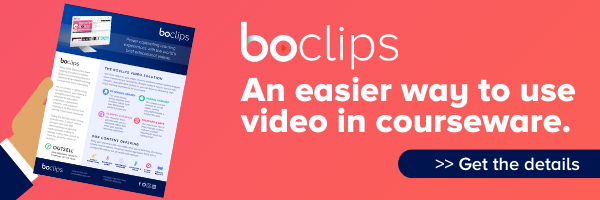Publishers and courseware creators face a great deal of complexity when seeking to incorporate more video content into their course materials. While they’ve developed efficient workflows to develop and source text as well as still images for their online offerings, video is another beast - one that many publishers and curriculum developers have yet to tame.
It’s not for lack of desire. Many if not most educational publishers have expressed an eagerness to incorporate complementary video material because they recognize the benefits of using video in the classroom, as well as the significant value it would add to their courseware. But many publishers avoid investing heavily in video because of the challenges associated with finding, licensing, and incorporating assets into their products. We've been hearing directly from publishers that the struggle to find or create video for online learning experience is real. These are the most common challenges we've heard over the years:
.jpg?width=567&name=headway-5QgIuuBxKwM-unsplash%20(1).jpg)
Challenge #1: Copyright hurdles for third-party video
Publishers and courseware creators know all too well the headaches that come with copyright clearance. Some of these challenges are not unlike the issues they face when trying to secure literature selections and other copyrighted texts. Sometimes rights-holders are vague or unclear on whether they even intend to grant permission. Sometimes they don’t respond at all! And sometimes the issue is finding a way to get ahold of them in the first place.
Copyright hassles can be even more frustrating when it comes to video. Many publishers and courseware creators avoid trying to secure rights for externally created video clips because they ultimately find that the hassle outweighs the benefits.
<<RELATED: Why Courseware Creators are Paying Attention to Video>>
Challenge #2: Prohibitive cost of licensing assets
Another reason we’ve heard from publishers who avoid or limit video content in their courses is the cost of video licensing. Most rights-holders and video creators are pricing their content for the commercial and media market, and educational publishers are simply priced out of the market.
Publishers know that adding high-quality video to their courseware would be a major selling point. But if the cost equals an unrealistic portion of the project budget, it isn’t going to happen.
Challenge #3: In-house production hassles
If third-party videos won’t work due to copyright hassles and burdensome licensing fees, another alternative is in-house video production. Some publishers have taken this route, but it comes with its own set of challenges.
All these challenges boil down to resources. Assuming you want to produce professional-quality content that’s in line with your brand standards, you’ll need proper facilities and video equipment. You’d also need to staff up: video production is going to require a cameraperson, a video editor, an audio editor, and more. And we haven’t even mentioned on-camera talent, make-up, sets or scripts!
We’ve heard from many courseware creators who would love to produce high-quality video in house but who don’t have the time, resources, or budgets to go down that road.

Challenge #4: Sourcing content is a full-time job
Another issue with sourcing third-party video content is that doing so can be massively time-consuming.
Publishers of any significant size already devote full-time resources to sourcing images. Consider the difference in time invested. It can take a reviewer just a couple seconds to rule out or select an image to complement the text at hand—sometimes it can take just a quick glance. But every video must be watched closely from start to finish, and the reviewer must evaluate multiple dimensions—audio quality, audio content, video production quality, what’s showing up in the background, not to mention the suitability of content for a given age level, topic, or learning objective.
It’s a much more labor-intensive process than photo selection, and the resources devoted to finding images and other media simply may not have the bandwidth to add this into their existing workflow.
Challenge #5: Dated, under-utilized content
Another issue with investing in video—whether third party or in-house—is the risk factor. Publishers have to invest significant time and effort into either procuring or creating video, but that video can become a liability.
Publishers can’t predict the future. That expensive, cutting-edge video content may begin looking badly dated only halfway through a product’s lifecycle. Or, worse, it could become awkward or offensive. Consider a video lesson about the late president Reagan, recorded in present tense the month before his death. By the time the video is ready to be used, it’s already dated.
For many publishers, this uncomfortable combination of both investment and risk makes them nervous about pushing too heavily into video.
<<Want to find out more about a curated, copyright-cleared solution to your video procurement needs? Schedule a consultation>>
Challenge #6: Broken Links
An alternative to everything we’ve covered thus far is to essentially crowdsource the expense and investment. Instead of producing or procuring video segments, publishers could (and sometimes do) link to existing content on sites like YouTube. This certainly can solve the problem of cost challenge, given that the videos on YouTube are free.
But the problems here are numerous. First, you can’t control the ads. Second, you can’t easily edit this kind of content, and finding a suitable, educationally aligned video can be time-consuming in its own right, given that YouTube isn’t curated for educational purposes.
Third, if you’re not hosting the video, you can’t guarantee that your links will work in the future. YouTube channels often take videos down, and if you’re using videos hosted on other less professional sites, the links are even more likely to change over time. While unlikely, there’s always the possibility that a URL gets hijacked, too. If an inappropriate video appeared in place of the one you linked to, what would that do to your company’s credibility?
Many publishers avoid linking, because they understand that when you put a URL to someone else’s video in materials, there’s no guarantee that the link will work when customers try to use it. This is especially problematic in printed products where you can’t push updates remotely. But even in digital products, the process of regularly checking all your third-party links can quickly turn into a logistical nightmare.

So what’s a courseware creator to do?
Today, 99% of institutions in the U.S. report that their teachers use video in the classroom, while 82% of teachers see their students demand for video as increasing (Kaltura, 2019). With that kind of demand, the answer for publishers and courseware developers isn’t to avoid video in curriculum. If anything, they need more video to enrich their lessons - they just need an easier, less labor-intensive way to include it.
Boclips offers a comprehensive solution that removes the pain points associated with video procurement. For example:
Challenge #1: Copyright hurdles
All 2 million-plus educational videos in our library are pre-cleared for global rights, making copyright hassles from multiple creators a thing of the past.
Challenge #2: Prohibitive cost of assets
We’re an education company serving education companies and institutions—not media—and our videos are priced accordingly.
Challenge #3: In-house production hassles
With access to Boclips’ robust video library, you won’t need to create your own videos.
Challenge #4: Sourcing content
Our clips are education-focused, saving you time weeding through “not quite right” (or even inappropriate) videos. We also have an in-house research team of former educators who can do the heavy lifting for you by recommending specific content to meet your requirements.
Challenge #5: Dated, under-utilized content
With an average of 5,000 videos added each month, there’s no shortage of fresh content to choose from. Plus, with our video streaming solution, publishers can swap out videos instantly, eliminating the worry about investing in an asset that goes unwatched or becomes dated.
Challenge #6: Broken links
Unlike the videos on YouTube, our content isn’t going anywhere. We offer the choice to either download and embed our content into your courses or stream our hosted videos directly into your platform integration via API so you can scratch broken links off your worry list as well.
In part because we offer solutions to these common procurement challenges—and in part because of our massive library of video clips from world-class content providers—Boclips has become the destination for short-form educational video. Publishers, courseware creators, and academic institutions have been turning to Boclips since 2014 to find, license, and implement video resources in their online curriculum.
Interested in learning more? You can watch this quick video or contact us to tell us about your video content frustrations and learn how we can help.
Boclips
Boclips is on a mission to make learning more captivating with video with an easier, safer way to access videos from the world’s leading video producers.
- #Classroom
- #Video in Digital Learning
- #Educational Videos
- #Tips for Using Video
- #Video Content Partners
- #Boclips for Publishers
- #Issues in Education
- #Educational Videos by Subject Area
- #News and Announcements
- #Events & Holidays
- #Video and Teaching Tools
- #Teaching Methodologies
- #Education Videos
- #Video and Digital Literacy
- #Short Educational Videos
- #Instructional Design
- #Multimodal Learning
- #Video and Student Safety
- #Accessibility in Education
-3.png?width=390&height=223&name=Untitled%20design%20(2)-3.png)


.png?width=1152&height=660&name=Copy%20of%20Untitled%20Design%20(1).png)




